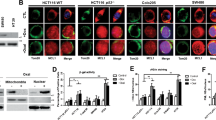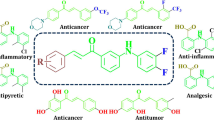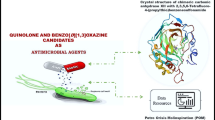Summary
Previous studies have demonstrated that novel molecular combinations of 5-fluorouracil (5FU) and 2-chloroethyl-1-nitrosourea (CNU) have good preclinical activity and may exert less myelotoxicity than the clinically used nitrosoureas such as 1,3-bis(2-chloroethyl)-1-nitrosourea (BCNU). This study examined the effect of O6-alkylguanine-DNA-alkyltransferase (ATase) depletion by the pseudosubstrate O6-benzylguanine (BG) on the anti-tumour activity and normal tissue toxicity in mice of three such molecular combinations, in comparison with BCNU. When used as single agents at their maximum tolerated dose, all three novel compounds produced a significant growth retardation of BCNU-resistant murine colon and human breast xenografts. This in vivo anti-tumour effect was potentiated by BG, but was accompanied by severe myelotoxicity as judged by spleen colony forming assays. However, while tumour resistance to BCNU was overcome using BG, this was at the expense of enhanced bone marrow, gut and liver toxicity. Therefore, although this ATase-depletion approach resulted in improved anti-tumour activity for all three 5-FU:CNU molecular combinations, the potentiated toxicities in already dose-limiting tissues indicate that these types of agents offer no therapeutic advantage over BCNU when they are used together with BG.
Similar content being viewed by others
Article PDF
Change history
16 November 2011
This paper was modified 12 months after initial publication to switch to Creative Commons licence terms, as noted at publication
References
Baer, J. C., Freeman, A. A., Newlands, E. S., Watson, A. J., Rafferty, J. A. & Margison, G. P. (1993). Depletion of O6-alkylguanine-DNA-alkyltransferase correlates with potentiation of temozolomide in human tumour cells. Br J Cancer 67: 1299–1302.
Bibby, M. C., Double, J. A., Wahed, I. A., Hirbawi (Abu-Khalaf), N. & Baker, T. G. (1988). The logistics of broader pre-clinical evaluation of potential anti-cancer agents with reference to anti-tumour activity and toxicity of mitozolomide. Br J Cancer 58: 139–143.
Bibby, M. C., Sleigh, N. R., Loadman, P. M. & Double, J. A. (1993). Potentiation of EO-9 anti-tumour activity by hydralazine. Eur J Cancer 29A: 897–906.
Bradford, M. (1976). A rapid and sensitive method for quantitation of microgram quantities of protein utilising the principle of protein-dye binding. Anal Biochem 72: 248–254.
Brennand, J. & Margison, G. P. (1986). Reduction of the toxicity and mutagenicity of alkylating agents in mammalian cells harbouring the Escherichia coli alkyltransferase gene. Proc Natl Acad Sci USA 83: 6292–6296.
Brent, T. P., von Wronski, M. A., Edwards, C. C., Bromley, M., Margison, G. P., Rafferty, J. A., Pegram, C. N. & Bigner, D. D. (1993). Identification of nitrosourea-resistant human rhabdomyosarcomas by in situ immunostaining of O6-methylguanine-DNA-methyltransferase. Oncol Res 5: 83–86.
Bronstein, S. M., Hooth, M. J., Swenberg, J. A. & Skopek, T. R. (1992). Modulation of ethylnitrosourea-induced toxicity and mutagenicity in human cells by O6-benzylguanine. Cancer Res 52: 3851–3856.
Chinnasamy, N., Rafferty, J. A., Hickson, I., Ashby, J., Tinwell, H., Margison, G., Dexter, T. M. & Fairbairn, L. J. (1997). O6-benzylguanine potentiates the in vivo toxicity and clastogenicity of temozolomide and BCNU in mouse bone marrow. Blood 89: 1566–1573.
Crone, T. M. & Pegg, A. E. (1993). A single amino acid change in human O6-alkylguanine-DNA alkyltransferase decreasing sensitivity to inactivation by O6-benzylguanine. Cancer Res 53: 4750–4753.
Dolan, M. E., Chae, M. Y., Pegg, A. E., Mullen, J. H., Friedman, H. S. & Moschel, R. C. (1994). Metabolism of O6-benzylguanine, an inactivator of O6-alkylguanine-DNA alkyltransferase. Cancer Res 54: 5123–5130.
Dolan, M. E., Corsico, C. D. & Pegg, A. E. (1985). Exposure of HELA cells to O6-alkylguanines increases the sensitivity to the cytotoxic effects of alkylating agents. Biochem Biophys Res Commun 132: 178–185.
Dolan, E. M., Moschell, R. C. & Pegg, A. E. (1990). Depletion of mammalian O6-alkylguanine-DNA-alkyltransferase activity by O6-benzylguanine provides a means to evaluate the role of this protein in protection against carcinogenic and therapeutic alkylating agents. Proc Natl Acad Sci USA 87: 5368–5372.
Dolan, M. E., Stine, L., Mitchell, R. B., Moschel, R. C. & Pegg, A. E. (1990). Modulation of mammalian O6-alkylguanine-DNA alkyltransferase in vivo by O6-benzylguanine and its effect on the sensitivity of a human glioma tumour to 1-(2-chloroethyl)-3-(4-methylcyclohexyl)-1-nitrosourea. Cancer Communications 2: 371–377.
Dolan, M. E. & Pegg, A. E. (1997). O6-benzylguanine and its role in chemotherapy. Clinical Cancer Research 3: 837–847.
Down, J. D., Boudewijn, A., Dillingh, J. H., Fox, B. W. & Ploemacher, R. E. (1994). Relationships between ablation of distinct haematopoietic cell subsets and the development of donor bone marrow engrafment following recipient pretreatment with different alkylating drugs. Br J Cancer 70: 611–616.
Dumenco, L. L., Allay, E., Norton, K. & Gerson, S. L. (1993). The prevention of thymic lymphomas in transgenic mice by human O6-alkylguanine-DNA alkyltransferase. Science 259: 219–222.
Fairbairn, L. J., Watson, A. J., Rafferty, J. A., Elder, R. H. & Margison, G. P. (1995). O6-benzylguanine increases the sensitivity of human primary bone marrow cells to the cytotoxic effects of temozolomide. Experimental Haematology 23: 112–116.
Geran, R. I., Greenberg, N. H., MacDonald, M. M., Schumacher, A. M. & Abbott, B. J. (1972). Protocols for screening chemical agents and natural products against animal tumours and other biological systems (third edition). Cancer Chemother Reports 3: 1–103.
Gerson, S. L., Trey, J. E. & Miller, K. (1988). Potentiation of nitrosourea cytotoxicity in human leukemic cells by inactivation of O6-alkylguanine-DNA alkyltransferase. Cancer Res 48: 1521–1527.
Hendriks, H. R., Piazo, P. E., Berger, D. P., Kooistra, K. L., Bibby, M. C., Boven, E., Dreefvandermeulen, H. C., Henrar, R. E. C., Fiebeg, H. H., Double, J. A., Hornstra, H. W., Pinedo, H. M., Workman, P. & Schwartsmann, G. (1993). EO9 – a novel bioreductive alkylating indolquinone with preferential solid tumour activity and lack of bone marrow toxicity in preclinical models. Eur J Cancer 29A: 897–906.
Hickson, I., Fairbairn, L. J., Chinnasamy, N., Margison, G. P., Dexter, T. M. & Rafferty, J. A. (1996). Protection of mammalian cells against chloroethylating agent toxicity by an O6-benzylguanine-resistant mutant of human O6-alkylguanine-DNA-alkyltransferase. Gene Ther 3: 868–877.
Hickson, I., Fairbairn, L. J., Chinnasamy, N., Dexter, T. M., Margison, G. P. & Rafferty, J. A. (1997). Towards gene therapy for stem cell protection using mutant human O6-alkylguanine-DNA alkyltransferase. Cancer Gene Ther 4: 70
Jelinek, J., Kleibl, K., Dexter, T. M. & Margison, G. P. (1988). Transfection of murine multi-potent haemopoietic stem cells with an E. coli DNA alkyltransferase gene confers resistance to the toxic effects of alkylating agents. Carcinogenesis 9: 81–87.
Jelinek, J., Fairbairn, L. J., Dexter, T. M., Rafferty, J. A., Stocking, C., Ostertag, W. & Margison, G. P. (1996). Long-term protection of haemopoiesis against the cytotoxic effects of multiple doses of nitrosourea by retrovirus-mediated expression of human O6-alkylguanine-DNA-alkyltransferase. Blood 87: 957–1961.
Kaina, B., Fritz, G., Mitra, S. & Coquerelle, T. (1991). Transfection and expression of human O6-methylguanine DNA-methyltransferase (MGMT) cDNA in Chinese hamster cells: the role of MGMT in protection against the genotoxic effects of alkylating agents. Carcinogenesis 11: 777–780.
Kurpad, S. N., Dolan, E. M., McLendon, R. E., Archer, G. E., Moschel, R. C., Pegg, A. E., Bigner, D. D. & Friedman, H. S. (1997). Intra-arterial O6-benzylguanine enables the specific therapy of nitrosourea-resistant intracranial human glioma xenografts in athymic rats with 1,3-bis(2-chloroethyl)-1-nitrosourea. Cancer Chemother Pharmacol 39: 307–316.
Lee, S. M., Thatcher, N. & Margison, G. P. (1991). O6-alkylguanine-DNA-alkyltransferase depletion and regeneration in human peripheral lymphocytes following dacarbazine and fotemustine. Cancer Res 51: 619–623.
Lee, S. M., Thatcher, N., Crowther, D. & Margison, G. P. (1992). In vivo depletion of O6-alkylguanine-DNA-alkyltransferase in lymphocytes and melanoma of patients treated with CB10-277, a new DTIC analogue. Cancer Chemother Pharmacol 31: 240–246.
Loadman, P. M., Matthew, A. M., McCormick, J. E., McElhinney, R. S. & Bibby, M. C. (1996). Pharmacokinetics and antitumour activity of B.4152, a reactive molecular combination of 5-fluorouracil and N-(2chloroethyl)-N-nitrosourea, and its uracil analogue. Anticancer Drug Des 11: 117–128.
Loktionova, N. A. & Pegg, A. E. (1996). Point mutations in human O6-alkylguanine-DNA-alkyltransferase prevent the sensitisation by O6-benzylguanine to killing by N,N′-bis(2-chloroethyl)-N-nitrosourea. Cancer Res 56: 1578–1583.
Lord, B. I., Marshall, E., Woolford, L. B. & Hunter, M. G. (1996). BB-10010/MIP-1α in vivo maintains haemopoietic recovery following repeated cycles of sublethal irradiation. Br J Cancer 74: 1017–1022.
Margison, G. P., Hickson, I., Jelinek, K. J., Elder, R. H., Rafferty, J. A., Faibairn, L. J., Dexter, T. M., Stocking, C., Baum, C., Ostertag, W., Donnelly, D., McMurray, T. B. H., McCormick, J. & McElhinney, R. S. (1996). Resistance to alkylating agents: more or less. Anticancer Drugs 7: 109–116.
Margison, G. P. & O’Connor, P. J. (1990). Biological consequences of reactions with DNA: role of specific lesions. In Handbook of Experimental Pharmacology 94/1, Cooper CS and Grover PL (eds) pp. 547–571. Springer-Verlag: Berlin
Matthew, A. M., Phillips, R. M., Loadman, P. M. & Bibby, M. C. (1993). Preclinical evaluation of a novel chloroethylating agent, clomesome. Br J Cancer 67: 441–446.
Matthew, A. M., Christensson, P. I., Seidegard, J., Tuvesson, H., Bibby, M. C., Hartleyasp, B. & Craven, P. J. (1994). Effect of drug scheduling on the anti-tumour activity and bone marrow toxicity of tauromustine (TCNU). International Journal of Oncology 4: 403–409.
McCoss, M., Chen, A. & Tolman, R. L. (1998). Synthesis of the chiral acyclonucleoside antiherpetic agent (S)-9-(2,3-dihydroxy-1-propoxymethyl)guanine. Tetrahedron Letters 26: 1815–1818.
McElhinney, R. S., McCormick, J. E., Bibby, M. C., Double, J. A., Atassi, G., Dumont, P., Pratesi, G. & Radacic, M. (1989a). Nucleoside analogues: 7. Effects on colon, breast and lung tumours in mice of 5-fluorouracil/nitrosourea combinations incorporating aloxy and oxidised sulphur fractions. Anticancer Drugs 3: 255–269.
McElhinney, R. S., McCormick, J. E., Bibby, M. C., Double, M. C., Atassi, G., Dumont, P., Pratesi, G. & Radacic, M. (1989b). Nucleoside analogues: 8. Some isomers of B.3839, the original 5-fluorouracil/nitrosourea molecular combination, and their effect on colon, breast and lung tumours in mice. Anticancer Drug Des 4: 1–20.
McMurray, T. B. H., McElhinney, R. S., McCormick, J. E., Elder, R. H., Kelly, J., Margison, G. P., Rafferty, J. A., Watson, A. J. & Willington, M. A. (1994). Preparation of O6-substituted guanine derivatives as anti-tumour agents. International Patent Application WO94/29, 312, 22 December
Mitchell, R. B., Moschel, R. C. & Dolan, M. E. (1992). Effect of O6-benzylguanine on the sensitivity of human tumour xenografts to 1,3-bis(2-chloroethyl)-1-nitrosourea and on DNA interstrand cross-link formation. Cancer Res 52: 1171–1175.
Moritz, T., Mackay, W., Glassner, B. G., Williams, D. A. & Samson, L. (1995). Retrovirus-mediated expression of a cDNA repair protein in bone marrow protects haematopoietic cells from nitrosourea-induced toxicity in vitro and in vivo. Cancer Res 55: 2608–2614.
Nakatsuru, Y., Matsukuma, S., Nemoto, N., Sugano, H., Sekiguchi, M. & Ishikawa, T. (1993). O6-methylguanine-DNA methyltransferase protects against nitrosamine-induced hepatocarcinogenesis. Proc Natl Acad Sci USA 90: 6468–6472.
Naundorf, H., Rewasowa, E. C., Fichtner, I., Buttner, B., Becker, M. & Gorlish, M. (1992). Characterisation of two human primary mammary carcinomas, MT-1 and MT-3, suitable for in vivo testing of ether lipids and their derivatives. Breast Cancer Res Treat 23: 87–95.
Newlands, E. S., Blackledge, G. R. P., Slack, J. A., Rustin, G. J. S., Smith, D. B., Stuart, N. S. A., Quarterman, C. P., Hoffman, R., Stevens, M. F. G., Brampton, M. H. & Gibson, A. C. (1992). Phase I trial of temozolomide (CCRG 81045: M and B 39831 NSC 362856). Br J Cancer 65: 287–291.
O’Reilly, S. M., Newlands, E. S., Glaser, M. G., Brampton, M., Rice-Edwards, J. M., Illingworth, R. D., Richards, P. G., Kennard, C., Colquhoun, I. R., Lewis, P. & Stevens, M. F. G. (1993). Temozolomide: a new oral cytotoxic chemotherapeutic agent with promising activity against primary brain tumours. Eur J Cancer 29A: 940–942.
Patchen, M. L. (1995). Amifostine plus granulocyte colony-stimulating factor therapy enhances recovery from supralethal radiation exposures: preclinical experience in animal models. Eur J Cancer 31A, S1: S17–S21.
Pegg, A. E. & Dolan, M. E. (1987). Properties and assay of mammalian O6-alkylguanine-DNA alkyltransferase. Pharmacol Ther 34: 167–179.
Pegg, A. E. (1990). Mammalian O6-alkylguanine-DNA alkyltransferase: regulation and importance in response to alkylating carcinogenesis and therapeutic agents. Cancer Res 50: 6119–6129.
Pegg, A. E. & Byers, T. L. (1992). Repair of DNA containing O6-alkylguanine. FASEB J 6: 2302–2310.
Pegg, A. E., Boosalis, M., Samson, L., Moschel, R. C., Byers, T. L., Swenn, K. & Dolan, M. E. (1993). Mechanism of inactivation of human O6-alkylguanine-DNA alkyltransferase by O6-benzylguanine. Biochemistry 32: 11998–12006.
Rafferty, J. A., Hickson, I., Chinnasamy, N., Lashford, L. S., Margison, G. P., Dexter, T. M. & Fairbairn, L. J. (1996). Chemoprotection of normal tissues by transfer of drug resistance genes. Cancer Metastasis Rev 15: 365–383.
Reese, J. S., Koc, O. N., Lee, K. M., Liu, L. L., Allay, J. A., Phillips, W. P. & Gerson, S. L. (1996). Retroviral transduction of mutant methylguanine DNA methyltransferase gene into human CD34 cells confers resistance to O6-benzylguanine plus 1,3-bis (2-chloroethyl)-1-nitrosourea. Proc Natl Acad Sci USA 93: 14088–14093.
Siemann, D. W. (1996). The in situ tumour response to combinations of cyclophosphamide and tirpazamine. Br J Cancer 74 S27: S65–S69.
Sieman, D. W. & Byers, K. L. (1993). In vivo therapeutic potential of combination thiol depletion and alkylating chemotherapy. Br J Cancer 68: 1071–1079.
Thompson, M. J., Abdul Rahman, S., Baker, T. G. & Bibby, M. C. (1996). Potentiation of testicular cytotoxicity by the alkyltransferase inhibitor O6-benzylguanine and the 5-fluorouracil/N-(2-chloroethyl)-N-nitrosourea molecular combination B.4152. Reprod Toxicol 10: 71–77.
Till, J. E. & McCulloch, E. A. (1961). A direct measurement of the radiation sensitivity of normal mouse bone marrow cells. Radiat Res 14: 213–222.
von Hofe, E., Fairbairn, L. & Margison, G. P. (1992). Relationship between O6-alkylguanine-DNA alkyltransferase activity and N-methyl-N′-nitro-N-nitrosoguanidine-induced mutation, transformation, and cytotoxicity in C3H/10T1/2 cells expressing exogenous alkyltransferase genes. Proc Natl Acad Sci USA 89: 11199–11203.
Walker, M. C., Masters, J. R. W. & Margison, G. P. (1992). O6-alkylguanine-DNA-alkyltransferase activity and nitrosourea sensitivity in human cancer cell lines. Br J Cancer 66: 840–843.
Wedge, S. R., Porteous, J. K., May, B. L. & Newlands, E. S. (1996). Potentiation of temozolomide and 1,3-bis(2-chloroethyl)-nitrosourea cytotoxicity of O6-benzylguanine: a comparative study in vitro. Br J Cancer 73: 482–490.
Wedge, S. R. & Newlands, E. S. (1996). O6-benzylguanine enhances the sensitivity of a glioma xenograft with low O6-alkylguanine-DNA alkyltransferase activity to temozolomide and BCNU. Br J Cancer 73: 1049–1052.
Yarosh, D. B. (1985). The role of O6-methylguanine-DNA methyltransferase in cell survival, mutagenesis and carcinogenesis. Mutat Res 145: 1–16.
Author information
Authors and Affiliations
Rights and permissions
From twelve months after its original publication, this work is licensed under the Creative Commons Attribution-NonCommercial-Share Alike 3.0 Unported License. To view a copy of this license, visit http://creativecommons.org/licenses/by-nc-sa/3.0/
About this article
Cite this article
Bibby, M., Thompson, M., Rafferty, J. et al. Influence of O6-benzylguanine on the anti-tumour activity and normal tissue toxicity of 1,3-bis(2-chloroethyl)-1-nitrosourea and molecular combinations of 5-fluorouracil and 2-chloroethyl-1-nitrosourea in mice. Br J Cancer 79, 1332–1339 (1999). https://doi.org/10.1038/sj.bjc.6690215
Received:
Revised:
Accepted:
Published:
Issue date:
DOI: https://doi.org/10.1038/sj.bjc.6690215



